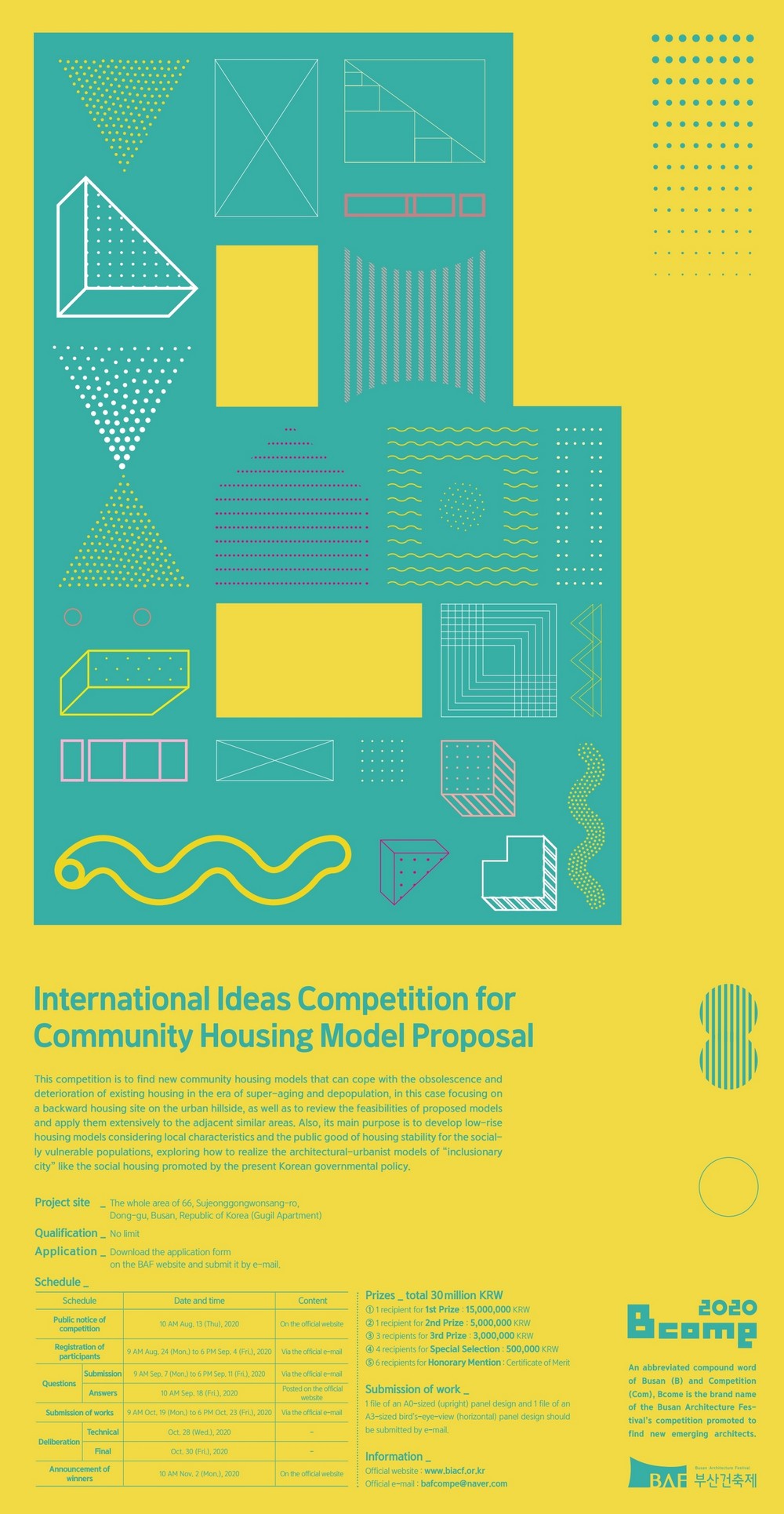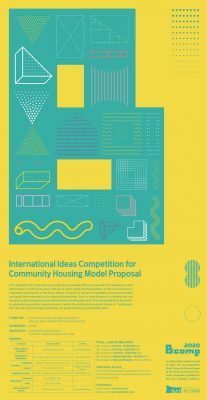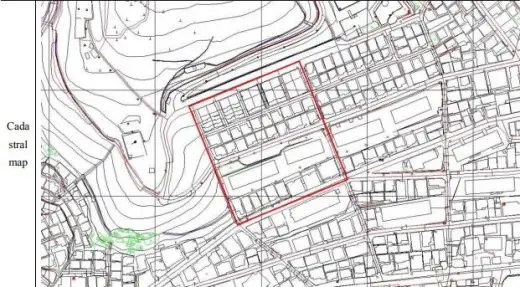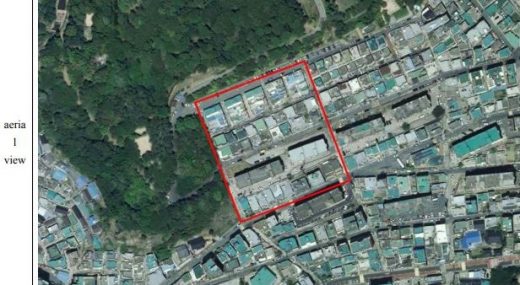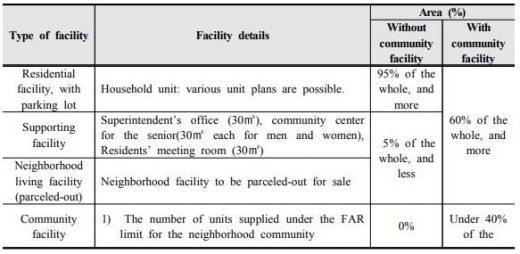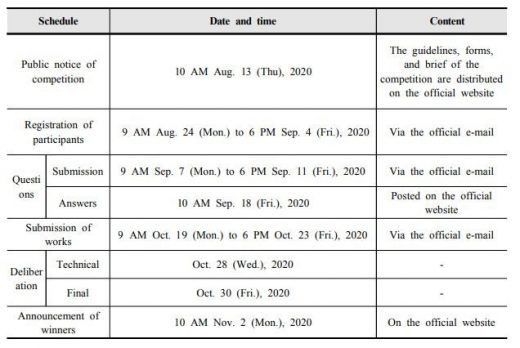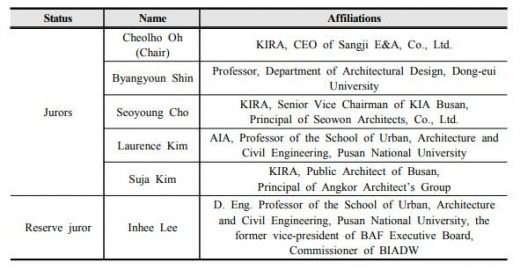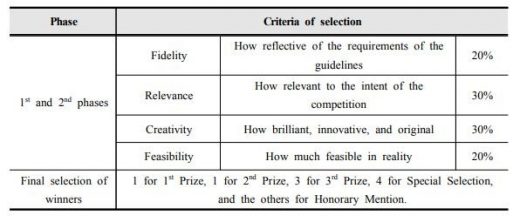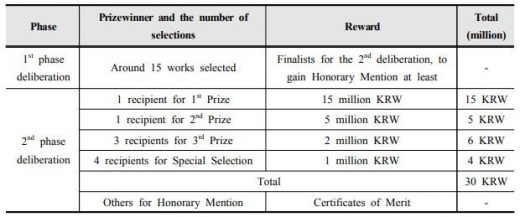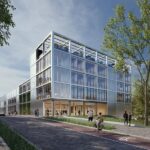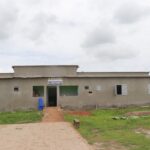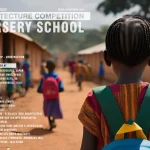Busan Architecture Festival, 2020 Bcome International Ideas Competition for community Housing Model Proposal
2020 Bcome International Ideas Competition News
24 Aug 2020
Bcome 2020 Competition Guidelines – Community Housing Model Proposal
2020 Bcome International Ideas Competition – Housing Model
Chapter 1. Brief of Competition
1.1 Title ············································································································································· 1
1.2 Site location ································································································································ 1
1.3 Background ··································································································································· 1
Chapter 2. Basic Guidelines
2.1 Theme and goal ························································································································· 2
2.2 Site information ···························································································································· 2
2.3 Method of competition ················································································································ 3
2.4 Programmatic orientations ··········································································································· 4
2.5 Benefits to the prizewinners ······································································································· 8
2.6 Disqualification criteria and limitations of liability ································································· 8
2.7 Materials offered ·························································································································· 9
Chapter 3. Details of Competition Procedure
3.1 The host and organizer ············································································································· 10
3.2 Competition type and qualifications ························································································ 10
3.3 Schedule of competition ············································································································ 10
3.4 Application and registration ······································································································ 11
3.5 Questions and answers ·············································································································· 11
3.6 Required materials to submit ··································································································· 11
Chapter 4. Submission of Work
4.1 Required work to submit ·········································································································· 12
4.2 Official languages and units ····································································································· 12
4.3 Team identification numbering and file naming ···································································· 13
Chapter 5. Deliberation and Prizewinning
5.1 Operation of a technical review committee ············································································ 14
5.2 Makeup and operation of a jury ····························································································· 14
5.3 Deliberation and selection criteria ···························································································· 15
5.4 Announcement of selections ····································································································· 15
5.5 Prizewinning and rewards ········································································································· 15
5.6 Limitations of liability on copyright ······················································································· 16
5.7 Attached forms ··························································································································· 16
Chapter 1. Brief of Competition
1.1 Title of competition : Bcome 2020
– International Ideas Competition for Community Housing Model Proposal –
1.2 Site location: the whole area of 66, Sujeonggongwonsang-ro, Dong-gu, Busan, Republic of
Korea (Gugil Apartment)
The general condition of the project site
1) Land Area: about 11,757 sq. m.
2) Use Area: second-kind general residential area
3) Building coverage : up to 60%
4) Floor-area-ratio: up to 210% (adjustable within the range of ±5%)
1.3 Background
1) In the era of super-aging and depopulation, Bcome 2020 is to discover new community
housing models that can cope with the obsolescence and deterioration of a backward housing
on the urban hillside of Busan, as well as to review the feasibilities of proposed models and
apply them extensively to adjacent similar areas.
2) The main purpose is to develop low-rise housing models considering local characteristics and
the public good of housing stability for the socially vulnerable populations, exploring how to
realize the architectural-urbanist models of “inclusionary city” like the social housing promoted
by the present Korean governmental policy.
3) Our programmatic suggestion of social housing is to enable the resettlement of existing
residents as an alternative to the existing practice of urban renewal due to urban deterioration
and hollowing-out, exploring how to provide the sustainable rights to housing for the
socioeconomically vulnerable, improve the environment for their stable dwelling and maintain
their community.
4) It is primarily to develop social housing models by the public expenditure for the
neighborhood living facilities as social overhead capital to secure urban infrastructure and for
the reconstruction of collective housing to improve dwelling environment.
Chapter 2. Basic Guidelines
2.1 Theme and goal
1) The theme of Bcome 2020 is to “suggest community housing models,” the social housing
models that can achieve the resettlement of existing residents and the housing stability of the
socially vulnerable, based upon public expenditure.
2.2 Site information
1) Range of the site: the whole area of 66, Sujeonggongwonsang-ro, Dong-gu, Busan, Republic of
Korea (Gugil Apartment)
2.3 Method of competition
This competition is an online international ideas competition open to all people and professionals
in and out of country. There is no entry fee, and amongst the submitted works, finalists will be
selected through deliberation and awarded totally 30 million KRW.
2.4 Programmatic orientations
1) Site location: the whole area of 66, Sujeonggongwonsang-ro, Dong-gu, Busan, Republic of
Korea (Gugil Apartment)
A. Use area: 2
nd-type general residential area
B. Building coverage ratio (BCR): up to 60%
C. Floor area ratio (FAR): up to 210% (adjustable within the range of ±5%, excluding the
basement area)
2) Scale of project
A. Site area: about 11,757㎡
B. Programmed scale and use
– Number of units: 350 units
※ adjustable within the range of ±5%, and autonomously reducible when including local
community facilities (the social overhead capital for neighborhood living)
– The gross floor area around 39,000㎡ (adjustable within the range of ±5%)
– Number of stories: up to 15 stories above ground
– Use: social collective housing, community facility, neighborhood facility and the like
– Expected construction cost: about 51.8 billion KRW (including direct construction cost,
design supervision cost, and other construction cost)
– An example of unit sizes and the numbers of households (adjustable within the range of
±10%): under the national housing scale (85 sq. m.), mainly for single-person households,
the senior, the young, and newly-weds
Size Number of units Proportion
24㎡ type 156 45%
51㎡ type 106 30%
84㎡ type 88 25%
Total 350 100%
– Building program and scale:
3) Basic direction
A. Suggest an inclusionary housing model that ameliorates any backward hillside housing for
the low-income class and enables their community to be sustained.
B. Suggest a sustainable complex model of landscape, topography, and community that can
enliven the local identity.
C. Suggest a model that can give a creative and figurative image fit for the hillside
topography of Busan.
D. Suggest a long-lived economic housing system (lasting for more than 50 years).
E. Create a smart village promotable in parallel with urban regeneration and base-circulatory
redevelopment to cope with depopulation.
F. Make an architectural-urbanist suggestion that enables physical environmental amelioration of
backward housing for the Busan community; the social environment where existing
residents can keep staying; and the economic community that guarantees work-housing
proximity for the residents.
G. Suggest a way in which this housing model becomes the primary living base at any old
hillside village of Busan including the North Port area and also can be modified variously
into other models (such as for-the-vulnerable, for-the-youth, for-the-middle-class, and
high-end) according to the locality and social program, while transportation, information,
and personal networks can be achieved between the model bases.
4) Outline and area of the main facilities
A. You may suggest the facilities as combinations of low-rise and high-rise structures, which
are encouraged to form a residential complex in a low-rise high-density concept considering
the sloped topography and the surrounding landscape.
B. Make a reasonable plan considering the types of prospective residents such as tenants or
homeowners.
C. You should reference the area standards for each detailed use, but insofar as you reflect
and comply with the intent of this competition, you are free to alter the details of room
areas and floor-based zoning so as to suggest an efficient direction of basic direction.
5) Application of creative concepts on apartment planning
A. You may apply flexible types of housing blocks and units with plans, sections, and
elevations that can spatially respond to the change of residents’ needs.
B. Adopt a modular (dimensional unit) system for structure and planning
C. You may suggest the method of approach by combining staircase-type, corridor-type, and
hall-type, considering the intent of the competition.
D. You are encouraged to make it easy to periodically remodel or repair the plan with the
concept of low-cost housing applied to construction, services, and materials.
6) Application of environment-friendly concepts
A. Make most of natural energies and resources.
B. Reduce the loads of environmental pollution, save resources, and introduce recycling
elements in your design.
C. Introduce the environmental design elements for the healthy and amenity interior.
D. Provide efficient layout, proper open space and rest zones.
7) Suggestions for the residents’ community, improvement of habitability, creation of amenity
environment, and supplementation of urban infrastructure.
A. Assume the class of prospective residents and suggest a facility program for their proper
community.
B. You may make suggestions for vertical passage, transportation, and accessibility
improvement.
8) Planning in consideration of constructability and the site condition
A. Design rationally and creatively to achieve the optimal effects of construction technique,
project period, construction cost, construction period, and maintenance fees.
B. Optimize the foundation work, number of stories, scale, and sectional planning, considering
the ground condition.
C. Plan an amenity dwelling condition that enables maintenance, safe from the surrounding
noxious elements such as indoor and outdoor noises, dust, air pollution, vibration, and
electromagnetic wave, and enabling emergency evacuation.
9) Site and circulation planning
A. Establish a rational layout and circulation plan that enables the designer to display creativity
befitting the surrounding condition and sloped topography in accord with the basic direction
of design.
B. Place facilities properly considering orientations, views, landscape, and the convenience of
users, planning the site and the outdoor space with the horizontal and vertical circulations
that can be used conveniently and efficiently by residents.
C. Clearly distinguish between the walkway and the road for safe walking, considering the
surrounding stairway and the road condition.
D. Plan amenity landscape and outdoor space in organic relationship and spatial hierarchy with
vertical passage, entry space, rest zone, garden space, stepped square, and outdoor common
vegetable garden, considering the indoor and outdoor environment.
E. The entryway shall fully satisfy the function of parking entrance and maintenance, with
rational suggestions of pedestrian entryway, connecting walkway, and automobile circulation.
F. Plan the circulation to enable efficient response, evacuation and fire truck access in case of
fire and emergency.
G. Plan the zoning, buffer facilities and space, layout, building coverage ratio, parking, and
circulation, considering the social network of various prospective residents.
H. Apply the principles of universal design.
10) Floor planning
A. Make a plan that enables the flexible integration or combination of housing units so as to
accommodate various types of lifestyle.
B. Consider the community connection by units and classes, secure proper extra space, and
plan the space to create a pleasant atmosphere.
C. Prioritize evacuation and safety by zoning based on areas and functions as well as planning
simple and clear circulations inside and outside.
D. Induce the change of space and shape by suggesting various forms of corridors and
balconies.
11) Facade design
A. Avoid unnecessary and excessive facade design, excluding as much facade design elements
unrelated to space and function as possible but focusing on internal practical uses.
B. Design creative structures and forms in harmony with the surrounding buildings and
landscape.
C. You may give changes to the rooftop and the like.
12) Sectional planning
A. Plan so as not to be damaged by natural disasters, and considering the sloped topography,
minimize the amount of cutting and filling the earth if any basement structure should be
installed.
B. Consider the organic relationship between spaces when planning horizontal and vertical
circulations.
C. Suggest the sectional planning on the surfaces of the adjacent roads and the site given the
use of the building.
D. Rationally plan the spaces by applying proper heights in accordance with the uses, areas,
and characteristics of rooms.
E. Suggest the sectional planning in consideration of vertical flexibility, unit combination, and
periodical remodeling.
13) Environment-friendly design
A. Apply building and finish materials that are durable, weather-proof, and easily maintainable.
B. For rainwater drainage, utilize permeation as much as possible to improve the ground
surface permeability.
C. Utilize highly permeable materials for the pavement of walkways, and reflect eco-friendly
pavement in the design for roads and the parking lot.
D. Green the roof so as not to reduce as much the durability of the building as possible,
actively introducing daylighting and natural ventilation for the energy-saving of the
building..
E. Consider environment-friendly concepts in terms of energy-saving and ecology.
14) Structural design
A. Apply a modular (dimensional unit) system and suggest a stable structural method so as to
make a economic and safe building.
B. You may suggest a structural method based on the concept of long-lived apartment
planning.
C. Maximize the structural beauty of the building frame by pursuing its safety, economic
feasibility, and structural rationality as befits the sloped topography.
15) Landscaping
A. Make the outdoor space and the skyline in harmony with the sloped topography and the
surrounding landscape.
B. Establish a plan that can enliven the neighborhood living landscape as residential
environment in harmony between the facilities and the surrounding context.
C. Establish an organic plan of pavement and landscaping with respective concepts of
landscaping system as befits housing units, outdoor streets, flower beds, pocket yards, and
rooftop space.
16) Parking scheme
A. Secure the legal minimum of parking volume, considering such types as electric vehicles.
B. Consider the approach of fire rescue vehicles in case of emergency.
C. Make the different kinds of parking surfaces such as those for the disabled, for light-weight
vehicles, for general vehicles, and for extended use, and secure the safe pedestrian path as
befits the old, weak, and disabled.
D. The relevant regulation on parking lot installation
Related legislation (Article 27 of the Regulation on Housing Construction Standards)
① For a housing complex, one shall install a parking lot according to the following standards
(the final number below decimal point is considered one).
1. For a housing complex, one shall install a parking lot with its volume not less than the
calculation based on the rate of volume per area in the following table, but include at least 1
car per household (0.7 if the area for exclusive use is not more than 60 sq. m.)
(Area for exclusive use: sq. m.) by the size of house
Parking lot installation standard (car(s)/sq. m.) : 85 sq. m. and less
B. Metropolitan Cities, Special Autonomic Cities, and the Cities within the Seoul Metropolitan Area : 1/85
2. For a studio house according to Article 10, Section 1, No. 1 of the Enforcement Decree of
the Housing Act, one shall install a parking lot with its volume not less than 0.6 car per
household (0.5 if the area for exclusive use is not more than 30 sq. m.) despite the No. 1
clause above.
2.5 Benefits to the prizewinners
1) Including the 1st Prize of 15 million KRW, totally 30 million KRW will be awarded to 9
recipients of main prizes, and the certificates of merit under the name of Busan Architecture
Festival will be issued to many recipients of Honorary Mention.
2) The 1st Prizewinner and the other main winners are slated to be exhibited in Busan
Architecture Festival 2020 followed by the relevant publication of them.
2.6 Disqualification criteria and limitations of liability
1) A work of another person, a copy of another work in and out of country, and a same or
similar work submitted to another competition will be excluded from deliberation or
disqualified in prizewinning.
2) Even after the announcement of selections, any work determined to meet any criterion of
disqualification may be disqualified, so that the organizer can cancel the awarding and
confiscate the prize money.
3) For the guidelines and relevant materials for this competition, you can download them from the
Busan Architecture Festival website (www.biacf.or.kr). In the event of any change, it will be
publicly announced on the website.
4) You shall apply after being well aware of the content of this competition guidelines, and any
disadvantage due to the lack of understanding the guidelines is the liability of the applicant.
5) Participants are considered to have agreed on these by submitting their works.
2.7 Materials offered
1) Design guidelines (PDF)
2) Photographs of the site (JPEG)
3) A digital map of the site (DWG)
Chapter 3. Details of Competition Procedure
3.1 The host and organizer
1) The host and organizer of the competition: Busan Architecture Festival Organizing Committee
A. Address: Siminsarangchae, Busan Citizens Park, 73 Simingonwon-ro, Busanjin-gu, Busan,
Republic of Korea 47197
B. Telephone: 82-51-744-7728~9, Fax: 82-51-744-7730
C. Official e-mail: bafcompe@naver.com
D. Official website: www.biacf.or.kr
3.2 Competition type and qualifications
1) Competition type: International ideas competition
2) Qualifications for participation
A. All people interested in urban regeneration in and out of country, including majors and
professionals in architecture, urbanism, environmental design, and landscape architecture, can
participate in this competition.
B. You may apply as an individual or a team (within 5 members). As a team, you shall pick
a representative applicant.
C. Any team applicant cannot participate in more than one team.
3.3 Schedule of competition
3.4 Application and registration
1) Period of application: 9 AM Aug. 24 (Mon.) to 6 PM Sep. 4 (Fri.), 2020
2) Place of announcement: the website of Busan Architecture Festival (www.biacf.or.kr)
3) How to apply: submit the Application for Participation (Form 1) via the official e-mail
(bafcompe@naver.com)
4) The competition schedule is subject to further possible changes, and the changed schedule will
be posted on the website of Busan Architecture Festival and notified separately to the
registered participants.
3.5 Questions and answers
1) Questions and answers will be communicated once for every applicant (company).
2) All questions shall be written in Korean or English. Submit the provided form Questions (Form
2) via the official e-mail (bafcompe@naver.com) within the period.
3) Answers will be posted all at once on the official website so as for all participants to share.
4) The answers to the questions will be considered an addition or modification to these
guidelines, and have the same force as them (the questions and answers will take priority).
5) In the Questions form, the inquirer shall necessarily fill out his/her address, name, telephone
number, and e-mail address.
3.6 Required materials to submit (Download the following forms from Announcement on the
website(www.biacf.or.kr).)
1) Application for Registration (Form 1): to be submitted at the phase of registration.
2) Questions (Form 2): during the period of submitting questions after registration.
3) List of Competition Participants (Form 3), Consent of Design Competition Regulation (Form 4),
and Consent of Publication and Display (Form 5): at the phase of registration.
4) These forms shall be filled out in Korean or English.
Chapter 4. Submission of Work
4.1 Required work to submit
1) For deliberation, submit 1 file of an A0-sized panel design (at least JPEG 200 dpi) and 1 file
of an A3-sized bird’s-eye-view panel design (at least JPEG 200 dpi) on line
(bafcompe@naver.com)
2) The A0-sized panel shall be upright, while the A3-sized panel horizontal.
4.2 Official languages and units
1) The official languages for this competition are Korean and English.
2) The official numerals are Arabic.
3) All documents submitted during this competition shall be filled out in Korean or English, and
if need be, both languages can be used together.
4) The official measuring units for this competition are as per the metric system.
5) The date and time mentioned in the competition regulation & guidelines and the questions &
answers are as per Korean Standard Time (KST: GMT+09).
4.3 Team identification numbering and file naming
1) For the team identification numbering, the first letter must be an uppercase English Alphabet
and the next five digits can be any Arabic numerals determined by the team (eg. A12345).
2) Refer to the following example and notate the team ID number on the white background at
the upper right corners of both A0-sized and A3-sized panels
– Submit the two JPG files via e-mail, and the files shall be named the series of the team ID
number, a hyphen (-), the number 1 or 2, and “.jpg.” (eg. A12345-1.jpg / A12345-2.jpg)
Chapter 5. Deliberation and Prizewinning
5.1 Operation of a technical review committee
1) The deliberation takes two phases through the first technical review session.
2) The technical review committee consists of three relevant professionals, who will review the
violations of submitted works based on the whole regulations and guidelines of the competition
and the relevant laws before the jury opening.
3) The technical committee shall review the violation of the guidelines, the infeasibility due to
legal violation and the like, and report the review result to the jury.
5.2 Makeup and operation of a jury
1) The jurors shall be selected within 6 persons (5 prescribed jurors and 1 reserve juror), and the
jury’s written opinions of deliberation will be opened on the website for a fair process.
2) Chair of jury
A. The Chair of Jury supervises the deliberation process of this competition and decides on
the details necessary for the process through the agreement of the jury.
3) Jurors
A. The jurors decide on whether to subtract the points of or disqualify the submitted works
for their violation of the guidelines.
B. They decide on the prizewinners, and write the jury report including the reasons for the
selection of winners.
4) Grounds for disqualification
A. Any direct or indirect behavior (eg. request or contact) affecting the fair evaluation of a
juror.
B. In the event of discovering any crucial fault such as a false report on the submitted
materials or the serious omission of a task prescribed on the guidelines.
5.3 Deliberation and selection criteria
1) Around 15 works will be selected through the 1
st phase of deliberation, and those works
selected will be under examination of the 2
nd phase jury so as to select the final winners. The
works selected at the 1
st phase receive the status of Honorary Mention at least.
2) The deliberation and selection criteria are as follows:
5.4 Announcement of selections
1) The selection results of this ideas competition will be published via the website, media and
publication, and notified separately to the finalists. Individual inquiries on the result are not
allowed.
2) The deliberation result of the jury is final so that any objection or appeal to it cannot be
submitted. If any proper work is found to be worthy of winning a prize during the jury
session, such a prizewinner may not be selected.
5.5 Prizewinning and rewards
1) The reward will be offered in Korean Won (KRW).
2) For team applicants, the reward will be offered to the representative applicant. For overseas
prizewinners, it will be offered in US Dollars as per the exchange rate at the time of
rewarding (within 30 days after the announcement of selections).
3) The reward includes copyright fee, tax, and charges due to the remittance of currency
exchange, and will be offered under the Korean tax law.
5.6 Limitations of liability on copyright
1) The submitted work shall be the applicant’s own creation and shall not infringe on the
copyright of another person. All liabilities due to the infringement on another person’s
copyright are of the participant (team), and if the participant is a prizewinner in this case, the
prizewinning may be cancelled.
2) Copyright is owned by the applicant, and the competition organizer has the right to use the
works submitted at the 1
st and 2
nd phases for the purpose of publishing the book, posting on
the website, and holding the exhibition about the works and finalists.
5.7 Attached forms
1) Form 1. Application for Registration
2) Form 2. Questions
2) Form 3. List of Competition Participants
3) Form 4. Consent of Design Competition Regulation
4) Form 5. Consent of Publication and Display
2020 Bcome International Ideas Competition images / information received 240820
Architectural Competitions
Current / Recent architectural contests on e-architect:
2A Continental Architectural Awards 2020
Network Rail Re-imagining Stations Competition
3rd Generation New Towns in Korea Design Contest
3rd Generation New Towns in Korea Architecture Competition
Tottenham Pavilion Competition
London Architectural Competitions
Main Library Gwangju Competition
LafargeHolcim Awards for Sustainable Construction
Flexible Housing Competition for Great Places Lakes & Dales Partnership
LFA 2020 Architecture Competition
Comments / photos for 2020 Bcome International Ideas Competition page welcome

